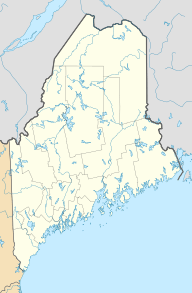Spednic Lake facts for kids
Quick facts for kids Spednic Lake |
|
|---|---|
| Location | Washington County, Maine, United States and York County, New Brunswick, Canada |
| Coordinates | 45°36′18″N 67°37′40″W / 45.6051°N 67.6278°W |
| Type | mesotrophic |
| Primary inflows | Mud Lake Stream (at times also called the St. Croix River) and at least 20 other waterways |
| Primary outflows | St. Croix River |
| Catchment area | 413 sq mi (1,070 km2) |
| Basin countries | Canada, United States |
| Max. length | 17 mi (27 km) |
| Surface area | 17,219 acres (6,968 ha) |
| Average depth | 20 ft (6.1 m) |
| Max. depth | 54 ft (16 m) |
| Shore length1 | 105.9 mi (170.4 km) |
| Surface elevation | 380 ft (120 m) |
| Islands | multiple |
| Settlements | Canada: North Lake Parish / McAdam Parish USA: North Washington / Vanceboro |
| 1 Shore length is not a well-defined measure. | |
Spednic Lake is a large lake located on the border between the United States and Canada. It's sometimes called Spednik Lake or Spednick Lake. The lake is part of the Chiputneticook Lakes chain. It is known for its excellent bass fishing.
The international border between Maine (USA) and New Brunswick (Canada) runs right through the middle of the lake. A part of the lake, called Palfrey Lake, is entirely in Canada. These two lakes used to be separate. But after a dam was built, they joined together. Now they act as one big lake.
The first dam at the lake's exit was built in 1836. It raised the water level by 15-foot (4.6 m). This dam has been changed over time and is now called the Vanceboro Dam. The water flow from this dam is managed by a group called the International St. Croix River Board. This board helps both the US and Canada share the water fairly.
Most of the land around Spednic Lake is undeveloped. It is kept safe by conservation groups or the governments of Maine and New Brunswick. Some small parts are privately owned. In Maine, you can get to the lake from a public boat launch in Vanceboro. You can also bring canoes from other nearby waterways.
Contents
Exploring Spednic Lake's Fish and History
Fishing Fun at Spednic Lake
Fishing is a very important activity for the area around Spednic Lake. It brings many visitors and helps the local economy. The most popular fish to catch here are smallmouth bass, landlocked salmon, and white perch.
Other fish that anglers might find in the lake include:
- Brown bullhead (also called hornpout)
- Burbot (also called cusk)
- Chain pickerel
- Lake whitefish
- Pumpkinseed
- Rainbow smelt
- Yellow perch
Smaller fish that live in the lake include American eel, common shiner, creek chub, fallfish, golden shiner, landlocked alewives, ninespine stickleback, northern pearl dace, and white sucker.
The Story of Smallmouth Bass Fishing
Spednic Lake is famous for its smallmouth bass. These bass were brought to the area in the 1800s. They quickly grew in number and became a big part of the lake's fish population. Many outdoor magazines wrote about how amazing the fishing was here.
However, in the 1980s, the number of bass dropped a lot. Experts think this happened for a few reasons. One reason was that the number of alewife fish increased. Another reason was that the lake's water levels were lowered a lot. Changes in how fish could move through the river also played a role.
To help the bass, fishing for them was stopped for a while. These efforts have helped the bass population grow back. Even though there aren't as many very large, old bass as before, the fishing is getting better.
Landlocked Salmon and Other Fish
You can also find landlocked salmon in certain parts of the lake, including the Palfrey Lake arm. Some of these salmon are native to the lake, while others are added by people. If you want to fish for salmon, it's a good idea to hire a local guide.
The landlocked salmon have faced challenges. In 1997, a type of alewife fish was brought into the lake by accident. These alewives came from the Great Lakes. They have made it harder for the salmon to thrive.
Ancient Fish and Waterways
Scientists have found old evidence from about 2,000 B.C. This evidence shows that American shad and alewife used to swim through Spednic Lake. They were caught at Mud Lake Falls, which is a waterfall on the main river flowing into the lake. Since alewives couldn't get past this waterfall, it means they were laying their eggs in the lake itself.
Because the bass fishing declined, the fishway at the Vanceboro dam was changed in 1988. A fishway is like a special path that helps fish swim past dams. This change was made to stop alewives from entering Spednic Lake. But it still allowed salmon to pass through.
Later, there were discussions in 2001 and 2008 about letting alewives back into the river below the Vanceboro dam. These talks were not about letting them back into Spednic Lake itself. However, the history of fishing in Spednic Lake was a big part of these discussions. More than one-third of the alewife habitat in the St. Croix watershed is in or above Spednic Lake.
A Historical Settlement by the Lake
In 1861, during the American Civil War, some people who did not want to fight in the war settled near Spednic Lake. They built a village called the Musquash settlement. It was located on Skaddle ridge, overlooking the southeastern part of the lake.
The settlement grew until 1871. After that, fewer people lived there. Today, it is an archaeological site. This means it's a place where scientists study old human activity. A small village called Pemberton Ridge is now located there.



